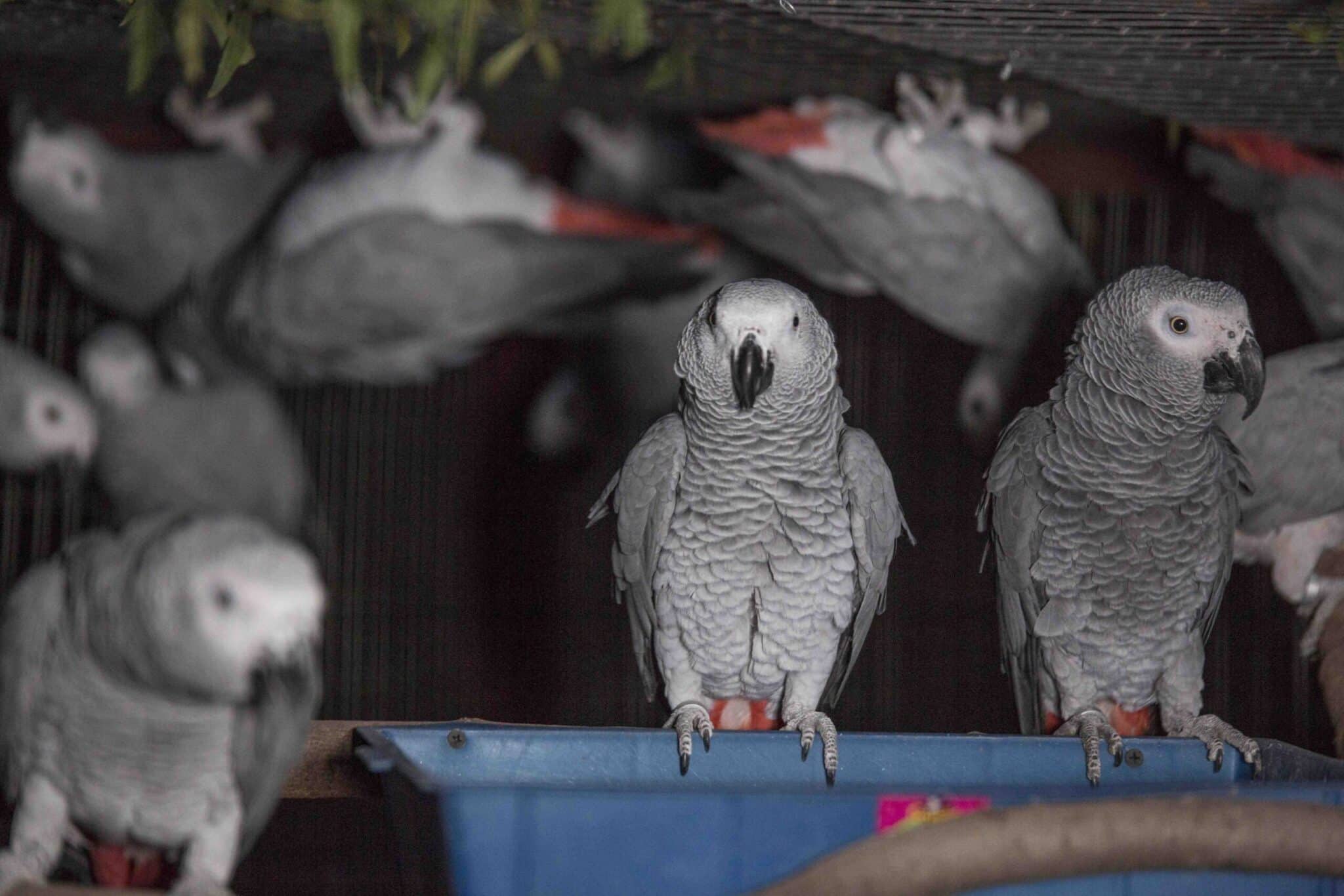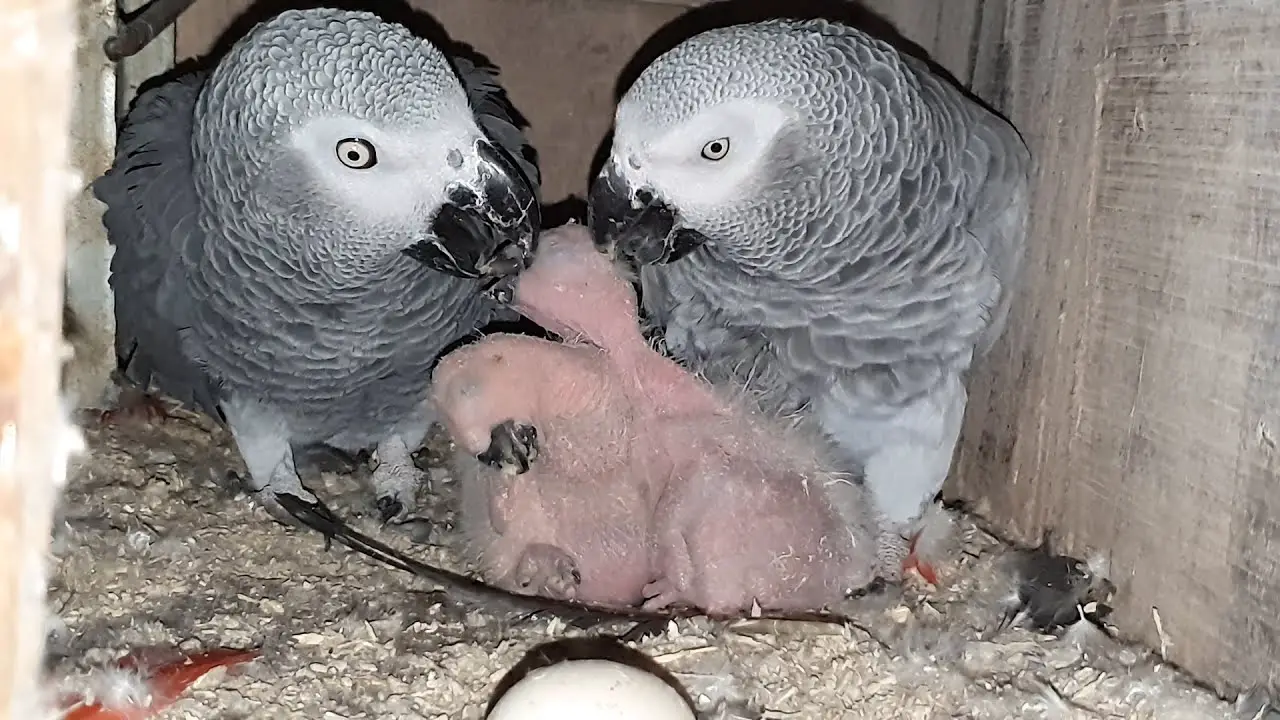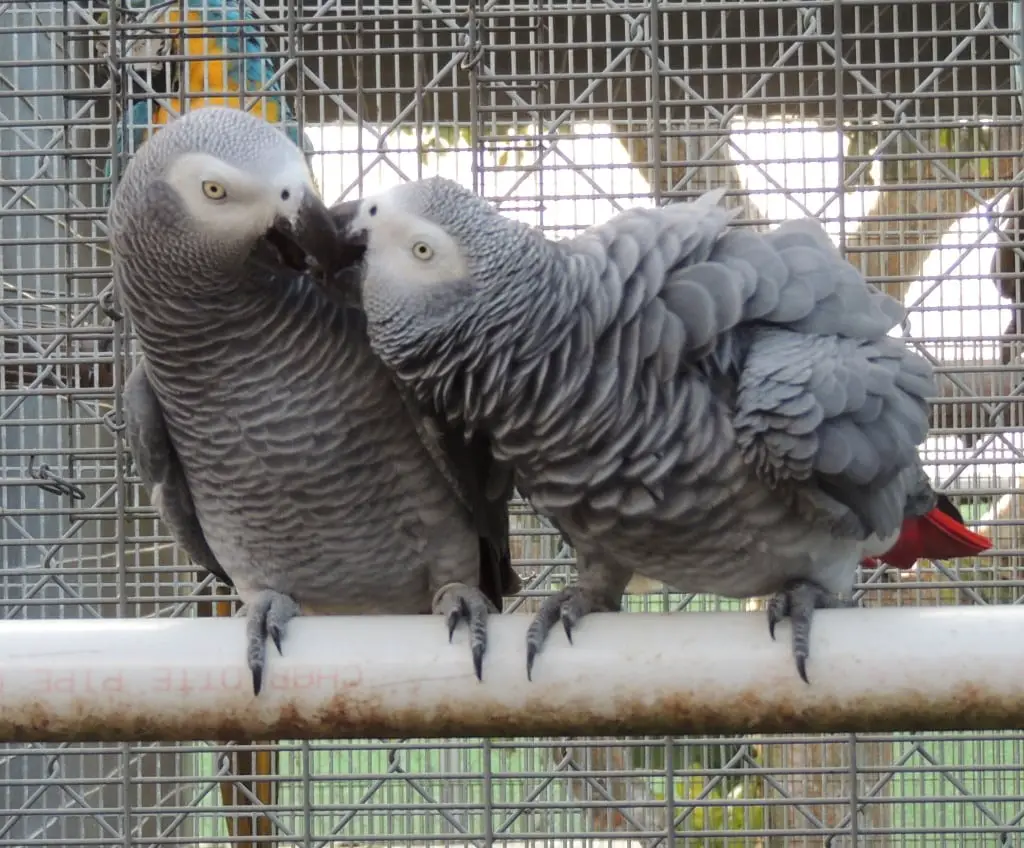Blogs, Species Guides
African Grey Parrots Breeding Guide & Tips
African Grey Parrots Breeding Guide & Tips
Are you a passionate parrot enthusiast looking to make a mark in the world of breeding? Or perhaps you already own African grey parrots and want to expand your knowledge to successfully breed them. Regardless of your experience level, this comprehensive guide is here to help you navigate the intricacies of breeding African grey parrots.
Known for their intelligence, charisma, and beautiful plumage, African grey parrots are a favorite among bird enthusiasts worldwide. However, breeding these magnificent creatures requires careful planning, attention to detail, and a deep understanding of their specific requirements.
In this guide, we will take you on a journey through the fascinating world of breeding African grey parrots. From understanding their unique breeding requirements to creating the ideal environment, selecting compatible pairs, and managing the breeding process, we will cover all the essential aspects to help you achieve success.
So, whether you dream of raising a healthy brood of African grey parrot chicks or are simply curious about the intricacies of parrot breeding, get ready to delve into the secrets of successful breeding.
Key Takeaways:
- Successfully breeding African grey parrots requires careful planning and attention to their specific requirements.
- Creating an optimal breeding environment is crucial for breeding success.
- Pairing compatible African grey parrots is essential for maximizing breeding potential.
- Understanding the breeding process, from courtship to chick rearing, is crucial for successful breeding.
- Knowing how to troubleshoot common breeding challenges is vital for beginner breeders.
Understanding African Grey Parrot Breeding Requirements
When it comes to breeding African grey parrots, understanding their specific requirements is essential for success. Several factors contribute to a successful breeding process, including age, health, diet, and environment.
Age
African grey parrots reach sexual maturity between the ages of 4 and 7 years. Breeding them before they are mature can lead to complications and unsuccessful breeding attempts. It is crucial to ensure that both the male and female parrots are of the appropriate age before attempting to breed them.
Health
Prior to breeding, it is important to ensure that both parrots are in excellent health. Regular veterinary check-ups and screenings for diseases common in African grey parrots, such as Psittacine Beak and Feather Disease, are essential. Breeding should only occur when both parrots are in optimal physical condition to increase the chances of successful breeding and produce healthy offspring.
Diet
A balanced and nutritious diet plays a pivotal role in the breeding process of African grey parrots. Fresh fruits, vegetables, high-quality pellets, and a variety of nuts should be included in their daily diet. Calcium-rich foods, such as cuttlebone and calcium supplements, are particularly important for female parrots during egg-laying and chick-rearing periods. Providing a well-balanced diet ensures the parrots have the necessary nutrients for successful breeding and healthy offspring.
Environment
The breeding environment plays a crucial role in the overall success of breeding African grey parrots. A spacious and well-ventilated breeding cage or aviary is essential. The nesting area should be cozy and provide privacy for the parrots. Adequate perches, nesting materials like wood shavings or shredded paper, and a stable temperature between 23-27 degrees Celsius (74-80 degrees Fahrenheit) are important factors to consider.
Expert Tips and Best Practices
Here are some expert tips and best practices to increase the chances of successful breeding:
- Pair parrots with compatible personalities and behaviors.
- Monitor the parrots’ behavior for courtship signs, such as regurgitation and mutual preening.
- Introduce breeding pairs gradually to prevent aggressive behavior.
- Provide a quiet and stress-free environment during the breeding process.
- Regularly clean and disinfect the breeding cage to maintain optimal hygiene.
By understanding and addressing the specific requirements of African grey parrots, breeders can optimize their breeding efforts and increase the chances of successful breeding.
Preparing the Breeding Environment for African Grey Parrots
A successful breeding process for African Grey Parrots begins with creating an optimal environment that caters to their specific needs. By providing the right conditions, you can maximize their chances of breeding success. This section will guide you through the essential steps and best practices for preparing the breeding environment.
1. Selecting Suitable Breeding Cages
When preparing the breeding environment for African Grey Parrots, it’s crucial to choose the right cages. The breeding cages should be spacious enough to accommodate both the breeding pair comfortably. It’s recommended to have separate cages for breeding and regular housing to minimize potential disturbances during the breeding process.
2. Providing the Right Nesting Materials
African Grey Parrots require suitable nesting materials to feel secure and comfortable during the breeding process. Provide them with a variety of options, such as nesting boxes, coconut fibers, untreated wood chips, and shredded paper. These materials will enable the parrots to construct their nests according to their natural instincts.
3. Maintaining Optimal Temperature and Lighting Conditions
Temperature and lighting play a crucial role in the breeding success of African Grey Parrots. Maintain a temperature range of 68°F to 78°F (20°C to 26°C) within the breeding area. Avoid exposing the breeding pair to extreme temperature fluctuations, as it can negatively impact their breeding behavior. Additionally, ensure that the lighting conditions mimic their natural habitat, providing a 12-hour light and 12-hour dark cycle.
4. Creating a Quiet and Calm Environment
An ideal breeding environment for African Grey Parrots should be free from excessive noise and disturbances. Avoid placing the breeding cages in high-traffic areas or near loud sources. This will help minimize stress on the breeding pair and promote a calm atmosphere, essential for successful breeding.
5. Ensuring a Nutritious Diet
Nutrition plays a vital role in the overall health and breeding success of African Grey Parrots. Provide a balanced and varied diet that includes high-quality pellets, fresh fruits, vegetables, and occasional treats. A well-rounded diet will ensure the parrots are in optimal condition for successful breeding.
By following these best practices and creating an ideal breeding environment, you can greatly enhance the chances of successful breeding for African Grey Parrots.
| Benefits of an Optimal Breeding Environment | Challenges of Inadequate Breeding Environment |
|---|---|
| – Increased breeding success rates | – Low breeding success rates |
| – Enhanced calming atmosphere for the breeding pair | – Increased stress levels in the breeding pair |
| – Improved chick health and development | – Poor chick health and development |
Pairing African Grey Parrots for Breeding
Pairing the right African grey parrots is one of the most crucial steps in the breeding process. By carefully selecting compatible pairs, considering genetic diversity, and observing their behavior, breeders can increase their chances of successful breeding. Here are some best practices for selecting and introducing breeding pairs:
1. Compatibility:
When pairing African grey parrots for breeding, it is important to choose birds that have compatible personalities and temperaments. Look for birds that show mutual interest and engage in courtship behaviors, such as mutual preening or regurgitation.
2. Genetic Diversity:
Inbreeding can result in genetic issues and compromised health in offspring. To avoid this, select breeding pairs that are not closely related. Ensure a diverse genetic pool by introducing birds from different bloodlines, preferably from unrelated breeders.
3. Behavioral Observation:
Observe the behavior of potential breeding pairs to gauge their compatibility. Pay attention to their interactions and communication, ensuring they are comfortable around each other and show mutual trust. A comfortable and balanced pair is more likely to exhibit successful breeding behaviors.
4. Introducing the Birds:
Introduce the breeding pair gradually to reduce stress and maximize compatibility. Start by placing their cages near each other, allowing them to hear and see each other without direct physical contact. As their comfort and tolerance levels increase, you can gradually move them closer until they are ready for physical interaction.
Pairing African grey parrots for breeding requires careful consideration of their compatibility, genetic diversity, and behavior. Following the best practices mentioned above will significantly increase the chances of successful breeding and the birth of healthy offspring.
The Breeding Process of African Grey Parrots
Successfully breeding African grey parrots involves understanding and managing each stage of the breeding cycle. From courtship behaviors and egg-laying to incubation and chick rearing, breeders must provide the right conditions and support for the parents and chicks.
1. Courtship Behaviors
African grey parrots exhibit specific courtship behaviors, such as vocalizations, dancing, and regurgitating food to impress potential mates. These behaviors may escalate as the birds form a bond.
2. Egg-Laying
When the female is ready to lay eggs, she will seek out a suitable nesting site. Breeders should provide nesting boxes with a soft substrate, such as wood chips or shredded paper, to mimic their natural environment. The female will typically lay 2 to 4 eggs, with an interval of 1 to 2 days between each egg.
3. Incubation
The female African grey parrot takes the lead in incubating the eggs, while the male supports her by providing food and ensuring her comfort. The incubation period usually lasts around 28 to 30 days. Breeders should monitor the temperature and humidity levels in the incubation area to ensure optimal conditions for the eggs to develop.
4. Chick Rearing
Once the eggs hatch, breeders must ensure a warm and stable environment for the chicks. The parents will provide them with food through regurgitation. As the chicks grow, breeders may introduce a variety of soft foods, such as fresh fruits and vegetables, to their diet. Regular check-ups by an avian veterinarian are essential to monitor the chicks’ health and development.
Monitoring and Well-being
Throughout the breeding process, it is crucial to monitor the behavior and health of both the parents and the chicks. Ensuring a stress-free environment, providing a balanced diet, and addressing any potential health issues promptly are essential for successful breeding.
By understanding the breeding process and providing the necessary care and support, breeders can contribute to the conservation of African grey parrots and the ongoing sustainability of their populations in captivity.
Troubleshooting Common Breeding Challenges with African Grey Parrots
While breeding African grey parrots can be a rewarding experience, it is not without its challenges. In this section, we will address common issues and challenges that breeders, especially beginners, may encounter during the breeding process. By understanding these challenges and implementing the right solutions and preventative measures, breeders can navigate potential hurdles successfully.
1. Breeding African Grey Parrots for Beginners
For beginner breeders, the process of breeding African grey parrots may seem overwhelming. It is important to start with a thorough understanding of the species’ breeding requirements, including age, health, and suitable nesting conditions. Best practices for breeding African grey parrots include providing a healthy diet, ensuring ample exercise and mental stimulation, and maintaining optimal temperature and humidity levels in the breeding environment.
2. Health Issues and Genetic Considerations
Health issues can arise during the breeding process, affecting the overall success rate. Breeding pairs should undergo a comprehensive health evaluation by a qualified avian veterinarian. Breeding African grey parrots with known genetic issues or deformities should be avoided to maintain the health and well-being of the offspring. Regular health checks and preventive measures such as vaccination and parasite control are essential for a successful breeding program.
3. Behavioral Challenges
Behavioral challenges can arise during breeding, such as aggression between mating pairs, egg abandonment, or chick neglect. Understanding the natural behaviors and social dynamics of African grey parrots is key to overcoming these challenges. Providing ample space and enrichment, implementing positive reinforcement training techniques, and closely monitoring pair interactions can help address and prevent behavioral issues during breeding.
4. Incubation and Chick Rearing
Successful incubation and chick rearing are critical stages of the breeding process. Breeders need to ensure that the eggs are properly incubated, maintaining the ideal temperature and humidity levels. Additionally, providing proper nutrition and creating a safe and nurturing environment for the chicks is crucial for their healthy development. Best practices for breeding African grey parrots include monitoring the progress of the eggs and chicks closely and seeking professional advice when necessary.
5. Lack of Breeding Success
In some cases, breeders may experience a lack of breeding success despite their best efforts. This can be disheartening, but it is important to remember that successful breeding is not guaranteed with every attempt. Factors such as pair compatibility, health issues, or environmental conditions may contribute to the lack of success. Breeders should remain patient, evaluate the potential causes, and seek guidance from experienced breeders or avian veterinarians if necessary.
Remember, breeding African grey parrots requires knowledge, patience, and dedication. By understanding common breeding challenges and implementing best practices, breeders can increase their chances of successful breeding and contribute to the conservation of this magnificent species.
Conclusion
In conclusion, this article has provided a comprehensive guide and expert tips for successfully breeding African grey parrots. By understanding their specific requirements, preparing the breeding environment, selecting suitable pairs, managing the breeding process, and troubleshooting common challenges, breeders can increase their chances of successful breeding.
Throughout this guide, we have emphasized the importance of breeding African grey parrots with care and attention to detail. From ensuring their health and nutrition to creating the right breeding environment, every step plays a crucial role in achieving breeding success.
By following the practical tips and best practices outlined in this African grey parrot breeding guide, breeders can embark on a rewarding journey of breeding these magnificent birds. Remember, patience and perseverance are vital qualities in the breeding of African grey parrots. With time and dedication, you can create a thriving breeding program and contribute to the conservation of these fascinating species.
FAQ
What are the age requirements for breeding African grey parrots?
African grey parrots typically reach sexual maturity between the ages of 3 and 5. It is important to wait until they have reached this age before attempting to breed them.
What should I feed my African grey parrots during the breeding process?
Providing a balanced diet is crucial for breeding success. Along with a high-quality pellet mix, include fresh fruits, vegetables, nuts, and seeds in their diet. Calcium-rich foods like cuttlebone or eggshells are essential for producing strong eggs.
How should I create a suitable breeding environment for African grey parrots?
Start by selecting a spacious cage with a nesting box that mimics their natural habitat. Provide suitable nesting materials such as wood shavings or paper for their comfort. Maintain a temperature of around 70 to 80 degrees Fahrenheit to ensure optimal conditions.
What factors should I consider when pairing African grey parrots for breeding?
Consider the age, health, and temperament of potential breeding pairs. Pair birds that are genetically diverse to avoid inbreeding. Ensure compatibility by observing their behavior and social interactions.
What is the breeding process for African grey parrots?
The breeding process begins with courtship behaviors, including vocalizations and displays. Once the female lays eggs, they are incubated for approximately 28 days. Both parents take turns incubating the eggs and feeding the chicks until they are ready to fledge.
What are some common breeding challenges with African grey parrots and how can they be resolved?
Common challenges include egg-binding, infertility, and parental aggression. Consulting with an avian veterinarian is recommended to address these issues. Providing a proper diet, ensuring a stress-free environment, and monitoring the birds’ health can help prevent such challenges.




